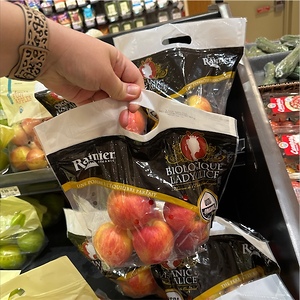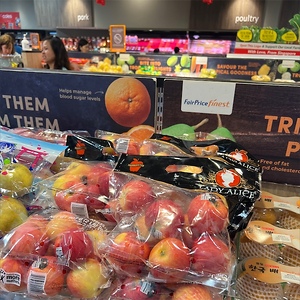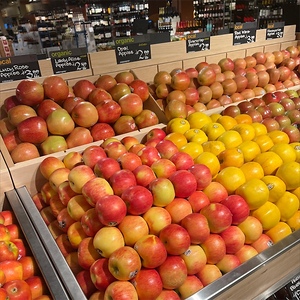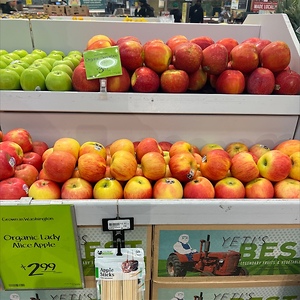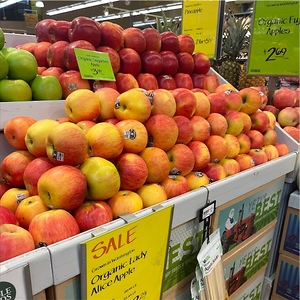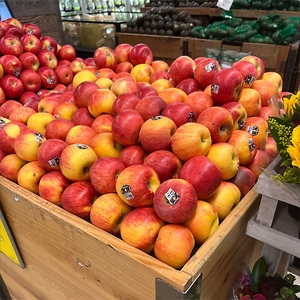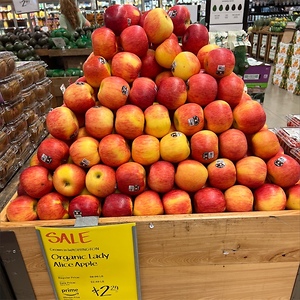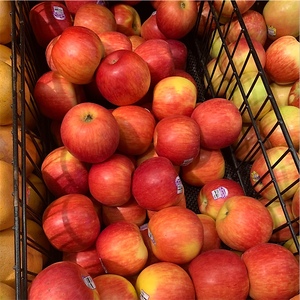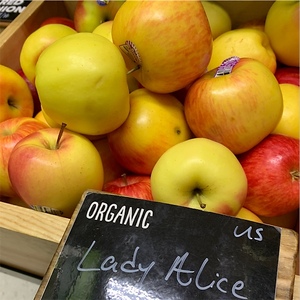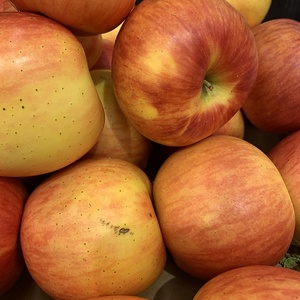

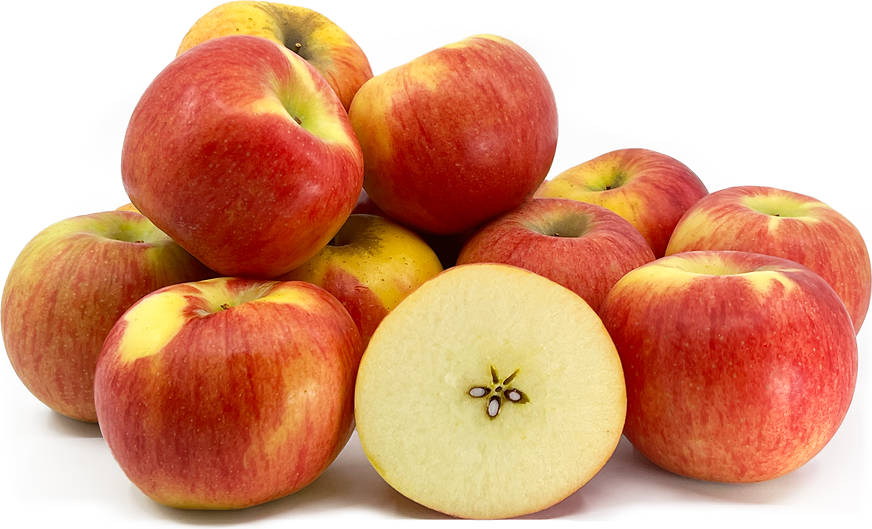
Lady Alice® Apples
Estimated Inventory, lb : 0
Description/Taste
Lady Alice apples are a medium to large-sized varietal, averaging 7 to 9 centimeters in diameter, and have a round appearance with a squat nature, slightly flattened on the shoulders and base with some ribbing. The apple's skin has a rich, golden-yellow hue and is almost entirely enveloped in pink and red blushing and striping. The amount of red coloration will vary depending on the fruit's exposure to the sun during cultivation, but some parts of the surface are saturated, solid red, while other portions allow the yellow to shine through the broken red, pink, and orange striping. The skin also has a smooth, taut, and matte feel, with prominent yellow-brown lenticels scattered across the surface. Underneath the semi-thick, snappy skin, the ivory-to-pale yellow flesh is fine-grained, dense, firm, and aqueous with a crisp, tender, and sturdy consistency. Lady Alice apples release a soft, sweet, and fruity aroma and have fairly balanced levels of sugar and acidity. This balanced nature creates a mild, sweet, and tart flavor with nuances of pineapple, vanilla, and almonds. It is important to note that Lady Alice apples will also improve in flavor with extended storage, developing added complexity and floral undertones.
Seasons/Availability
Lady Alice apples are harvested in the fall and can be stored through early spring.
Current Facts
Lady Alice apples, botanically classified as Malus domestica, are a modern American variety belonging to the Rosaceae family. The mid to late-season apples were discovered growing as a chance seedling on a Red Delicious tree in Washington in the late 20th century and were selected and propagated as a new commercial release in the early 21st century. Apple enthusiasts favor Lady Alice apples for their balanced, sweet-tart flavor, bright coloring, and extended storage capabilities. The variety is distinct from other cultivars as its flavor improves with storage and can be kept for several months without loss of firmness, taste, or crispness. When Lady Alice apples were first released, they were harvested in the fall and stored in controlled atmospheric environments for at least four months before they were sent to commercial markets. This allowed the variety to fill the gap of commercial apples available in the winter and gave consumers a versatile fruit, able to be cooked or consumed fresh. Since their release, Lady Alice apples have increased in popularity, and production has expanded, allowing the apples to be released throughout the fall and winter. Some are even found in markets into the early spring.
Nutritional Value
Lady Alice apples are a source of vitamin C to strengthen the digestive tract, vitamin A to maintain healthy organ functioning, and iron to develop the protein hemoglobin for oxygen transport through the bloodstream. The apples also provide potassium to balance fluid levels within the bloodstream, fiber to regulate the digestive tract, copper to control nerve operations, and other nutrients, including calcium, phosphorus, vitamin K, vitamin E, magnesium, manganese, and zinc.
Applications
Lady Alice apples have a sweet, subtly tart flavor suited for fresh and cooked preparations. The apples are popularly consumed out of hand as a dessert cultivar and are favored for their crisp consistency. Lady Alice apples also oxidize slowly when sliced, making them ideal for salads, fruit bowls, charcuterie boards, snacks, and sandwiches. Try serving the apples with nut butter, caramel, or chocolate as a sweet and tangy snack or incorporating the fruits into hot sandwiches such as paninis or grilled cheeses. Lady Alice apples can also be chopped fresh into slaws, used as a topping over oatmeal, yogurt, and cereal, or infused into syrups as a fruity enhancement. In addition to fresh preparations, Lady Alice apples hold their shape well when heated, allowing them to be baked into bread, muffins, tarts, turnovers, cakes, and doughnuts. The apple's dense flesh can also be sauteed in butter and tossed with cinnamon, diced and baked, or stuffed with dried fruits and nuts and wrapped in puff pastry. Beyond sweet dishes, Lady Alice apples complement roasted meats when cooked into applesauce or chutney or simmered into jams and jellies. The apples can also be roasted with root vegetables, mixed into stuffing, or cooked into soups. Lady Alice apples pair well with nuts such as almonds, hazelnuts, walnuts, and pecans, meats including pork, poultry, and beef, herbs such as thyme, rosemary, mint, and sage, and cheeses including cheddar, goat, feta, blue, and parmesan. Whole, unwashed Lady Alice apples can be stored for several months in a cool, dry, and dark location. In controlled atmospheric environments, the apples can be kept through March.
Ethnic/Cultural Info
Lady Alice apples are named after Alice Zirkle, the matriarch of the family who founded the Rainier Fruit Company in Washington. The chance seedling apples were discovered about 100 years after the Zirkle family moved to Washington, and the company felt it was fitting to honor Alice's legacy and passion for apples. The Zirkle family once lived in Antebellum, Virginia, where their family was multi-generational apple growers in the Shenandoah Valley. Their time in Virginia came to an end during the Civil War, and the family moved to Washington, establishing roots in Selah of the Yakima Valley around 1888. The Zirkle family selected the region for its budding apple farming and began growing, picking, polishing, and packing apples for local sale and transport to Portland. After almost a century of apple farming in Washington, the Zirkle family partnered with other family-owned operations to form the Rainier Fruit Company in 1973. This company was created to help market the apple varieties being grown by the families. Lady Alice apples were one of their first exclusive apples, fittingly named after their family's once fearless leader who loved to roam the apple orchards.
Geography/History
Lady Alice apples were discovered growing as a chance seedling in an orchard near Gleed, a city in Yakima County of Washington. The story goes that farmer Don Emmons was working in the orchard in 1979 when he accidentally sliced a Red Delicious tree with the disc of his plow. The injured tree survived and later sprouted a new shoot with apples distinct from the rest of the tree. Emmons noticed the fruit and partnered with the Rainier Fruit Company to evaluate and propagate the variety for over 25 years. Lady Alice apples were eventually released to commercial markets in 2008 and are a variety offered exclusively through Rainier Fruits in Washington. When in season, Lady Alice apples are shipped throughout the United States and Canada and are sold through select grocers, wholesale distributors, and specialty stores. The apples have also been shipped to export markets in Thailand, China, Vietnam, and Singapore.
Recipe Ideas
Recipes that include Lady Alice® Apples. One
| Butter with a Side of Bread |
|
Caramel Apple Bread |
| Contemplating Sweets |
|
Fresh Apple Mousse |



